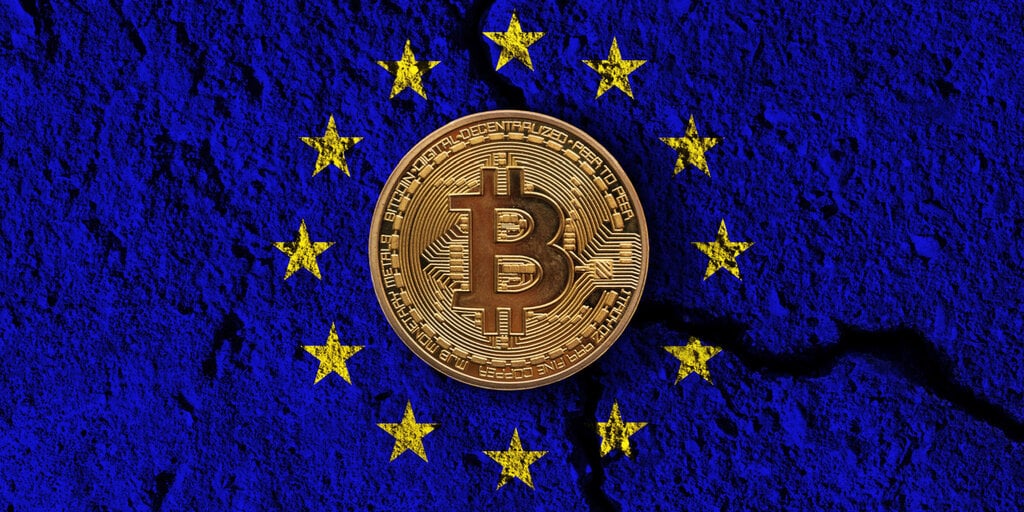
If the European Union’s sweeping crypto regulation framework were being decided now, it would already have a very different framework, the European Securities and Market Authority told Decrypt.
Earlier this week, ESMA published two new documents “encouraging preparations for a smooth transition” to MiCA (Markets in Crypto-Assets Regulation), the continent’s recently approved crypto-regulatory framework
Adopted in April this year, MiCA is Europe’s landmark regulatory sandbox for the digital asset industry. Lauded as the most significant package of crypto regulations worldwide, it will provide a plethora of new rules, including stringent regulation for stablecoins, profound anti-money laundering (AML) procedures and data security practices, and is set to go into full effect in July 2026.
For the ESMA, the message behind its recent statements was “not to stop all investments in crypto-assets, but to adopt a very high level of vigilance.” An agency spokesperson told Decrypt that they want investors to “maintain an alert mindset” when trading these assets in order to not give in to “siren calls of easy profits.”
They told Decrypt that many have been calling for MiCA 2.0, and claim that how the framework currently stands “somewhat acknowledges its own limits” given it adds mandates for the ESMA, European Banking Authority (EBA), and European Commission to monitor and propose legislative action regarding new developments in digital asset markets.
For ESMA, MiCA would “admittedly have a different scope if negotiated today, especially after the so-called crypto winter.”
In one of its letters, the ESMA encouraged crypto-asset providers (CASPs) and National Competent Authorities (NCAs) to prepare for MiCA’s implementation and transitional phase–along with a stark warning for investors.
The letter acknowledges that even despite the extensive regulatory framework, and the guidelines currently being delineated by the pertinent authorities, crypto assets should not be considered “safe” by investors, and that rights and protections under MiCA won’t go into effect until 2025.
For the ESMA, the message behind the letters statements was “not to stop all investments in crypto-assets, but to adopt a very high level of vigilance.” The spokesperson told Decrypt that the agency seeks for investors to “maintain an alert mindset” when trading these assets in order to not give in to “siren calls of easy profits.”
According to the agency, market abuses remain a widespread practice in the crypto industry, and it remains of utmost importance that consumers “understand” they will be able to access products from non-MiCA authorized entities as late as July 2026–and the dangers that ensue.
According to Patrick Hansen, Director, EU Strategy & Policy at Circle, EU citizens will still be able to use unregulated, third-country services, but the scope will be extremely narrow. Hansen wrote on Twitter that “third-country, unregulated firms will not be able to market their services in the EU at all, or target EU consumers in any way.”
In its new statement on MiCA timelines, ESMA (EU supervisor) encourages both CASPs (crypto-asset service providers) and NCAs (national supervisors) to prepare for MiCA entering into application and the MiCA transition phase.
Importantly, ESMA emphasizes what I and many others… pic.twitter.com/hwotl560Hp
— Patrick Hansen (@paddi_hansen) October 17, 2023
The policy expert added that details of this exemption will be published by ESMA in Q1, but “the last thing that EU supervisors want to see, after years of MiCA-related work, is foreign, unregulated businesses circumventing MiCA rules through reverse solicitation (exemption),” concluding that the scope will be, in ESMA terms, “very narrowly framed.”
In anticipation of next year, the ESMA issued an additional letter yesterday to the Economic and Financial Affairs Council (ECOFIN) urging local authorities to level the playing field across member states. That includes “inviting” member states to limit the duration of the grandfathering clause to a maximum of twelve months.
Grandfathering clause refers to allowing crypto companies to continue operating under the existing regulatory framework (or lack thereof) until they are granted or refused a MiCA authorization. According to the ESMA, the aforementioned clause is key, “because we don’t want the application of MiCA to be delayed.”
Having added context to its letters, ESMA’s spokesperson concluded that their priority remains a “harmonized implementation of the current framework,” which according to the agency “will remain valid,” as further regulatory developments take place.








